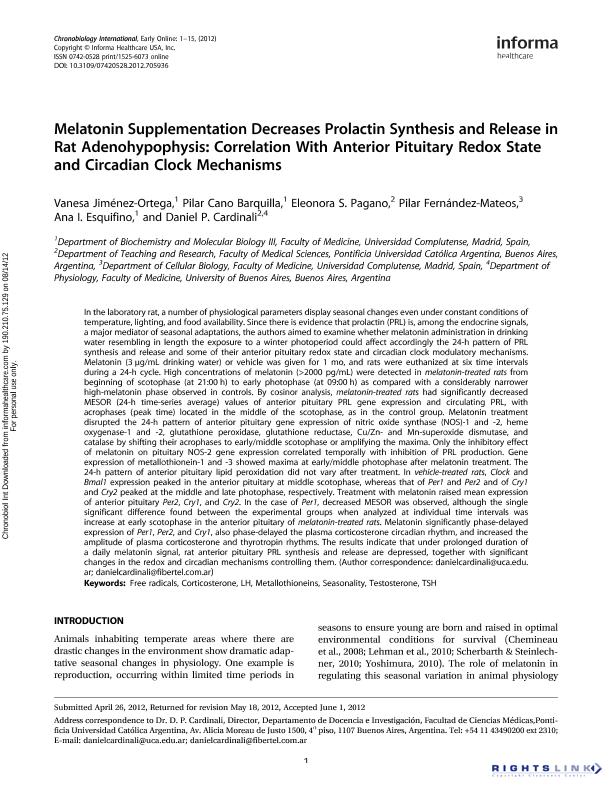Mostrar el registro sencillo del ítem
dc.contributor.author
Jiménez Ortega, Vanesa
dc.contributor.author
Barquilla, Pilar Cano
dc.contributor.author
Pagano, Eleonora Samanta

dc.contributor.author
Fernández Mateos, Pilar
dc.contributor.author
Esquifino, Ana I.
dc.contributor.author
Cardinali, Daniel Pedro

dc.date.available
2023-05-10T14:25:34Z
dc.date.issued
2012-08
dc.identifier.citation
Jiménez Ortega, Vanesa; Barquilla, Pilar Cano; Pagano, Eleonora Samanta; Fernández Mateos, Pilar; Esquifino, Ana I.; et al.; Melatonin supplementation decreases prolactin synthesis and release in rat adenohypophysis: Correlation with anterior pituitary redox state and circadian clock mechanisms; Taylor & Francis; Chronobiology International; 29; 8; 8-2012; 1021-1035
dc.identifier.issn
0742-0528
dc.identifier.uri
http://hdl.handle.net/11336/196970
dc.description.abstract
In the laboratory rat, a number of physiological parameters display seasonal changes even under constant conditions of temperature, lighting, and food availability. Since there is evidence that prolactin (PRL) is, among the endocrine signals, a major mediator of seasonal adaptations, the authors aimed to examine whether melatonin administration in drinking water resembling in length the exposure to a winter photoperiod could affect accordingly the 24-h pattern of PRL synthesis and release and some of their anterior pituitary redox state and circadian clock modulatory mechanisms. Melatonin (3gmL drinking water) or vehicle was given for 1 mo, and rats were euthanized at six time intervals during a 24-h cycle. High concentrations of melatonin (>2000 pgmL) were detected in melatonin-treated rats from beginning of scotophase (at 21:00h) to early photophase (at 09:00h) as compared with a considerably narrower high-melatonin phase observed in controls. By cosinor analysis, melatonin-treated rats had significantly decreased MESOR (24-h time-series average) values of anterior pituitary PRL gene expression and circulating PRL, with acrophases (peak time) located in the middle of the scotophase, as in the control group. Melatonin treatment disrupted the 24-h pattern of anterior pituitary gene expression of nitric oxide synthase (NOS)-1 and -2, heme oxygenase-1 and -2, glutathione peroxidase, glutathione reductase, CuZn- and Mn-superoxide dismutase, and catalase by shifting their acrophases to earlymiddle scotophase or amplifying the maxima. Only the inhibitory effect of melatonin on pituitary NOS-2 gene expression correlated temporally with inhibition of PRL production. Gene expression of metallothionein-1 and -3 showed maxima at earlymiddle photophase after melatonin treatment. The 24-h pattern of anterior pituitary lipid peroxidation did not vary after treatment. In vehicle-treated rats, Clock and Bmal1 expression peaked in the anterior pituitary at middle scotophase, whereas that of Per1 and Per2 and of Cry1 and Cry2 peaked at the middle and late photophase, respectively. Treatment with melatonin raised mean expression of anterior pituitary Per2, Cry1, and Cry2. In the case of Per1, decreased MESOR was observed, although the single significant difference found between the experimental groups when analyzed at individual time intervals was increase at early scotophase in the anterior pituitary of melatonin-treated rats. Melatonin significantly phase-delayed expression of Per1, Per2, and Cry1, also phase-delayed the plasma corticosterone circadian rhythm, and increased the amplitude of plasma corticosterone and thyrotropin rhythms. The results indicate that under prolonged duration of a daily melatonin signal, rat anterior pituitary PRL synthesis and release are depressed, together with significant changes in the redox and circadian mechanisms controlling them.
dc.format
application/pdf
dc.language.iso
eng
dc.publisher
Taylor & Francis

dc.rights
info:eu-repo/semantics/openAccess
dc.rights.uri
https://creativecommons.org/licenses/by-nc-sa/2.5/ar/
dc.subject
CORTICOSTERONE
dc.subject
FREE RADICALS
dc.subject
LH
dc.subject
METALLOTHIONEINS
dc.subject
SEASONALITY
dc.subject
TESTOSTERONE
dc.subject
TSH
dc.subject.classification
Fisiología

dc.subject.classification
Medicina Básica

dc.subject.classification
CIENCIAS MÉDICAS Y DE LA SALUD

dc.title
Melatonin supplementation decreases prolactin synthesis and release in rat adenohypophysis: Correlation with anterior pituitary redox state and circadian clock mechanisms
dc.type
info:eu-repo/semantics/article
dc.type
info:ar-repo/semantics/artículo
dc.type
info:eu-repo/semantics/publishedVersion
dc.date.updated
2023-05-10T10:29:48Z
dc.journal.volume
29
dc.journal.number
8
dc.journal.pagination
1021-1035
dc.journal.pais
Estados Unidos

dc.description.fil
Fil: Jiménez Ortega, Vanesa. Universidad Complutense de Madrid; España
dc.description.fil
Fil: Barquilla, Pilar Cano. Universidad Complutense de Madrid; España
dc.description.fil
Fil: Pagano, Eleonora Samanta. Pontificia Universidad Católica Argentina "Santa María de los Buenos Aires"; Argentina. Consejo Nacional de Investigaciones Científicas y Técnicas; Argentina
dc.description.fil
Fil: Fernández Mateos, Pilar. Universidad Complutense de Madrid; España
dc.description.fil
Fil: Esquifino, Ana I.. Universidad Complutense de Madrid; España
dc.description.fil
Fil: Cardinali, Daniel Pedro. Universidad de Buenos Aires; Argentina. Pontificia Universidad Católica Argentina "Santa María de los Buenos Aires"; Argentina. Consejo Nacional de Investigaciones Científicas y Técnicas; Argentina
dc.journal.title
Chronobiology International

dc.relation.alternativeid
info:eu-repo/semantics/altIdentifier/url/http://informahealthcare.com/doi/abs/10.3109/07420528.2012.705936
dc.relation.alternativeid
info:eu-repo/semantics/altIdentifier/doi/http://dx.doi.org/10.3109/07420528.2012.705936
Archivos asociados
